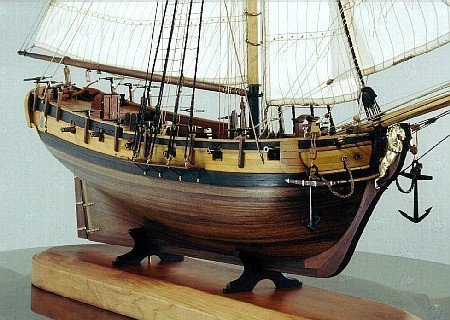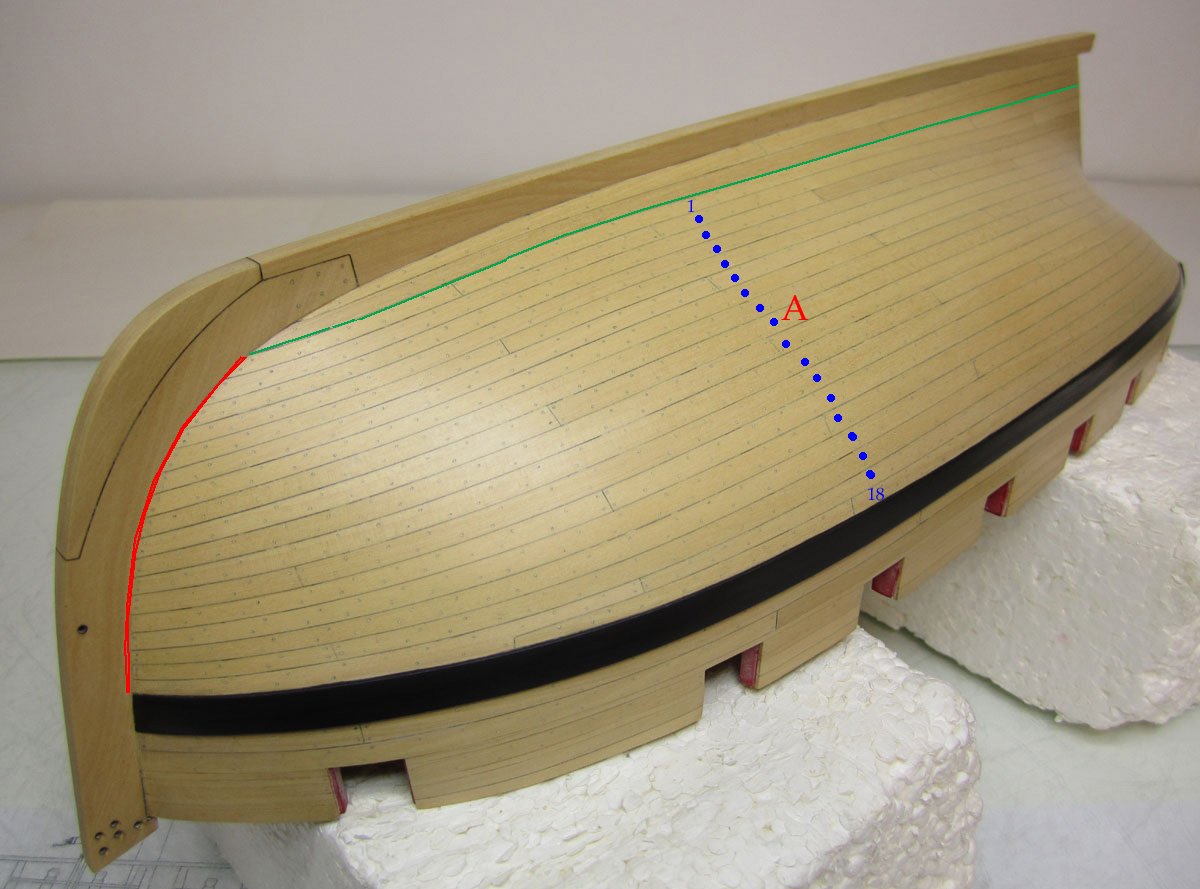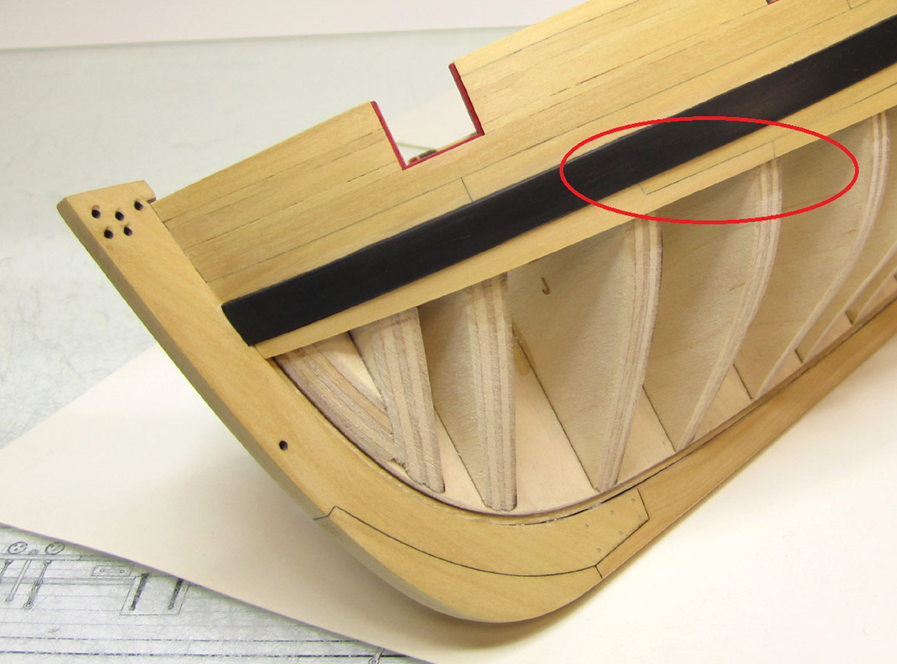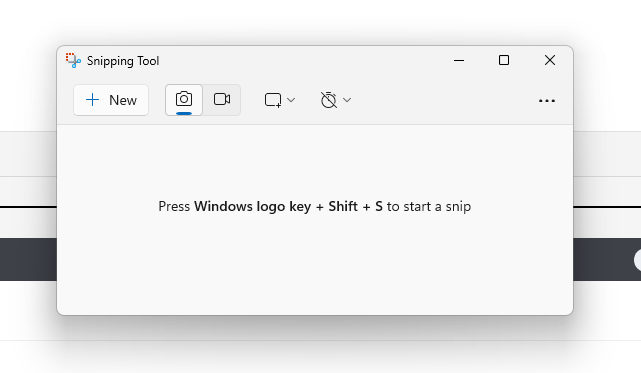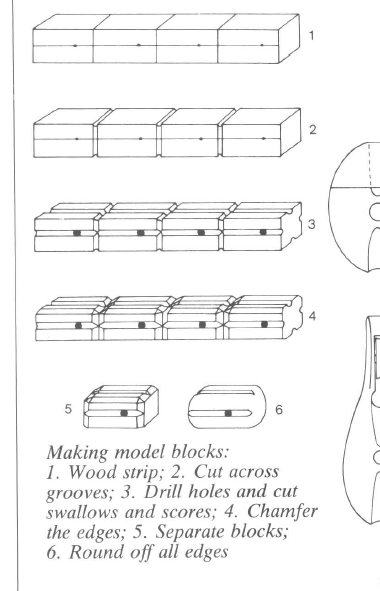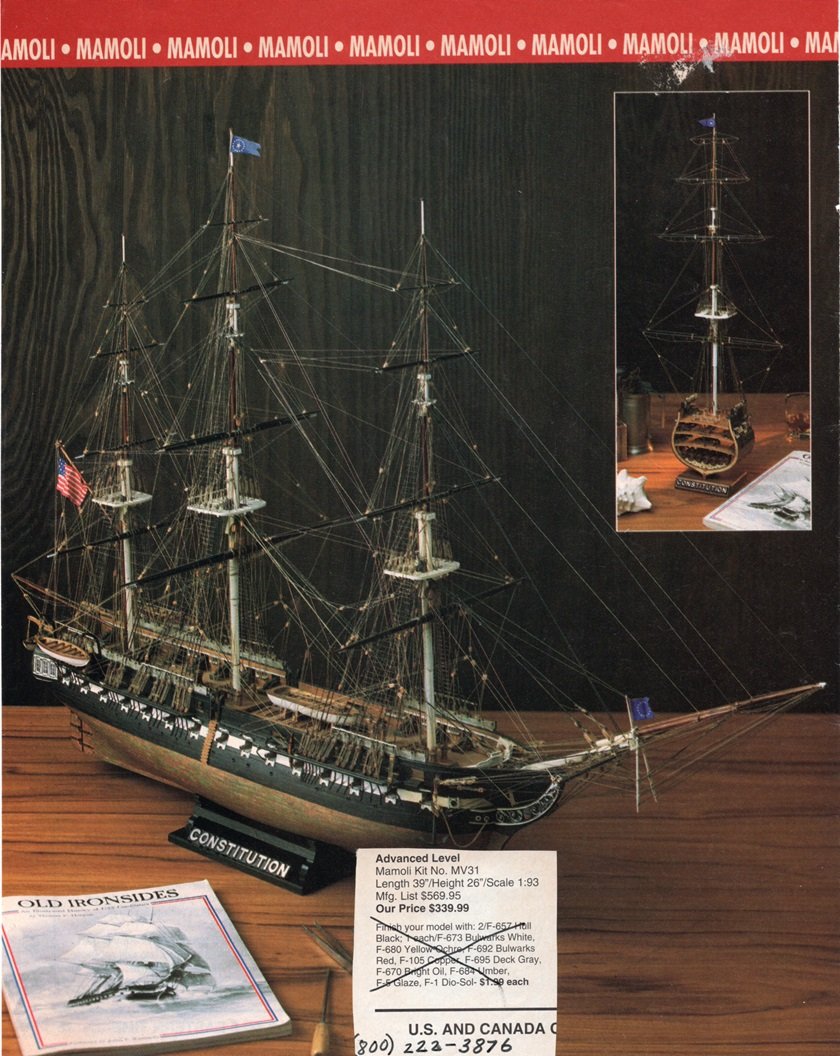-
Posts
3,136 -
Joined
-
Last visited
Content Type
Profiles
Forums
Gallery
Events
Everything posted by Gregory
-
Hopefully you will take the advice to look at the references given . Here is another example from Chuck's Cheerful. The green line shows where the first two planks next to the keel are. The first plank next to the keel is the garboard, and you may want to look at Thukydides reference for establishing the garboard plank. I also discounted the next plank because it doesn't lend itself to measuring a width where it meets the stem. You will have to try to achieve the look you see on those two planks and taper them accordingly. The red line is the distance you will measure to determine the width of the planks at the bow. If you measure the red line to be 55mm, then would divide 55 by 18 to get 3.05 mm for the width of your planks at the red line. Since your number may be something that is really hard to measure for cutting, such as 3.05 mm, then you may want to use just 3mm ( just an example as your actual number will probably be different ), and have one or two planks a little bigger. You could just fit them in at the end. Unless you follow the planking practices you have been given, you will not have an easy time achieving something like the picture above. Look at the many build logs for Cheerful and Alert. The planking details may not be well documented in all of them, but it will be in a few like the one Thukydides pointed you to.
-
Do you have any illustration of what you mean by this? It's basically a matter of dividing the space available by the number of planks. Have you looked at the planking videos by Chuck? They show how to get a better fit of the planks by 'edge bending'. Sometimes a " drop plank " at the bow will help you avoid planks that become too narrow at the stem. A drop plank reduces two planks to one. The problem with doing this with a kit is that it requires wider stock than the basic planking stock, so it may not be practical with the kit you are building. You should be able to work around this by just making the ends of the planking more narrow than the drop plank would provide. I assume we are talking bout the Sherbourne you are building, so I think you could get some ideas by looking at Chuck's Cheerful. The lines are very similar. It is a single plank model, but the run of the planking will be much the same as your 2nd planking on the Sherbourne. Chuck has the instructions for Cheerful at his Syren Ship Model Co. Here is a link to Chapter 4 which covers the planking below the wales.
-
Go to Windows search and type " snipping tool ".. You can copy any part of the screen you are looking at. It goes to the clip-board, so you can paste it directly into the discussion. You can edit in "Paint", or do whatever you like. Even though it's telling you to press all those keys, all you really need to do is press Ctr+N..
-
Frayed lines
Gregory replied to Dindsy's topic in Building, Framing, Planking and plating a ships hull and deck
Perhaps if you go over the lines with a brush using diluted white glue or clear/matte acrylic it will make it look a lot better. I would dilute about 4 to 1.. Your model looks really great for a first time build. -
I think we would nee to see a picture to make an informed response. I googled up quite a few images with " wavertree ship new york ", and I really didn't see anything that looked out of place.
-
It depends on which lines they are. When it comes to rigging there is really no such thing as "taboo", it is either right or wrong. The rigging is what ships of war and clippers have most in common as far as function goes, and it is not that different. The rigging is part of a machine. The components have to be in the place they belong in order for the machine to work. If it is not a working machine, then there could be any number of out of place elements.
-
Kit review 1/50 - HMS Supply - Artesania Latina - by Kevin
Gregory replied to Kevin's topic in REVIEWS: Model kits
It means it qualifies to be sold in the gift shop of a museum..😁 Regarding comments on historical accuracy, if that were something most kit builders were concerned with, most kit manufacturers might as well close up shop. For those who don’t care to lower their standards to build a kit, much less one with some historical inaccuracies, we shouldn’t discourage those who want to enjoy the hobby by building these kits. Thanks for the review Kevin. -
Pricing at that ModelNet site looks very competitive….
-
Here is one of my favorite references for making blocks from Mondfeld. I had just about got to the point of going forward with this method when Chuck started selling his blocks. You can see that taking it down to very small size is possible. If you have a small table saw, i.e., Proxxon, Byrnes, etc., it will really help with the grooves..
-
Atlas Press Tool Company
-
What do they look like?
-
Micro-Mark Desktop Dust Collection System
Gregory replied to eurekapaul's topic in Modeling tools and Workshop Equipment
Steve, I use a small USB fan for that purpose. The dust settles in a corner of my shop, and I vacuum it up. l was a little put off by the price of the MicroMark device, but really couldn’t comment from experience. Your information is very useful. -
Good work on the edge bending. It looks like the planks are laying flat on the bulkheads. are you foregoing tapering the planks at the bow for a reason? It’s not so important with the first layer, but will make a big difference with the 2nd layer..
- 87 replies
-
- Lady Nelson
- Amati
-
(and 1 more)
Tagged with:
About us
Modelshipworld - Advancing Ship Modeling through Research
SSL Secured
Your security is important for us so this Website is SSL-Secured
NRG Mailing Address
Nautical Research Guild
237 South Lincoln Street
Westmont IL, 60559-1917
Model Ship World ® and the MSW logo are Registered Trademarks, and belong to the Nautical Research Guild (United States Patent and Trademark Office: No. 6,929,264 & No. 6,929,274, registered Dec. 20, 2022)
Helpful Links
About the NRG
If you enjoy building ship models that are historically accurate as well as beautiful, then The Nautical Research Guild (NRG) is just right for you.
The Guild is a non-profit educational organization whose mission is to “Advance Ship Modeling Through Research”. We provide support to our members in their efforts to raise the quality of their model ships.
The Nautical Research Guild has published our world-renowned quarterly magazine, The Nautical Research Journal, since 1955. The pages of the Journal are full of articles by accomplished ship modelers who show you how they create those exquisite details on their models, and by maritime historians who show you the correct details to build. The Journal is available in both print and digital editions. Go to the NRG web site (www.thenrg.org) to download a complimentary digital copy of the Journal. The NRG also publishes plan sets, books and compilations of back issues of the Journal and the former Ships in Scale and Model Ship Builder magazines.

